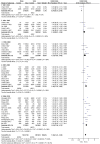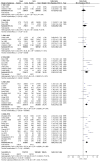Trends in overweight and obesity among children and adolescents in China from 1981 to 2010: a meta-analysis
- PMID: 23284829
- PMCID: PMC3524084
- DOI: 10.1371/journal.pone.0051949
Trends in overweight and obesity among children and adolescents in China from 1981 to 2010: a meta-analysis
Abstract
Background: Overweight/obesity is a serious public health problem that affects a large part of the world population across all age and racial/ethnic groups. However, there has not been a meta-analysis of the prevalence of childhood and adolescent overweight/obesity in China during the past 30 years.
Methods: The China National Knowledge Infrastructure and Wanfang DATA, MEDLINE, EMBASE and Cumulative Index to Nursing and Allied Health Literature were searched for relevant studies published between January 1970 and June 2012. The prevalence of overweight/obesity over time was pooled using Stata/SE, version 9. Summary statistics (odds ratios, ORs) were used to compare sex-specific and urban-rural preponderance of overweight/obesity using Review Manager.
Results: After screening 1326 papers, we included 35 papers (41 studies), most of medium quality. The prevalence of overweight/obesity increased from 1.8% (95% confidence interval [CI], 0.4%-3.1%) and 0.4% (95% CI, -0.1% to -0.8%) respectively in 1981-1985 to 13.1% (95% CI, 11.2%-15.0%) and 7.5% (95% CI, 6.6%-8.4%) respectively in 2006-2010. The average annual increase was 8.3% and 12.4% respectively. Boys were more likely to be overweight/obese than girls (OR, 1.36; 95% CI, 1.24-1.49 and OR, 1.68; 95% CI, 1.52-1.86 respectively). The prevalence of overweight/obesity was higher in urban areas than in rural areas (OR, 1.66; 95% CI, 1.54-1.79 and OR, 1.97; 95% CI, 1.68-2.30 respectively). For age-specific subgroup analyses, both overweight and obesity increased more rapidly in the toddler stage than in other developmental stages. Sensitivity analyses showed that sample-size differences, study quality, overweight/obesity criteria and geographical distribution affected overweight/obesity prevalence.
Conclusions: Toddlers and urban boys were at particularly high risk; the prevalence in these groups increased more rapidly than in their counterparts. Public health prevention strategies are urgently needed to modify health behaviors of children and adolescents and control overweight/obesity in China.
Conflict of interest statement
Figures
Similar articles
-
[Dynamic analysis on the prevalence of obesity and overweight school-age children and adolescents in recent 15 years in China].Zhonghua Liu Xing Bing Xue Za Zhi. 2004 Feb;25(2):103-8. Zhonghua Liu Xing Bing Xue Za Zhi. 2004. PMID: 15132859 Chinese.
-
Secular trend and projection of overweight and obesity among Chinese children and adolescents aged 7-18 years from 1985 to 2019: Rural areas are becoming the focus of investment.Chin Med J (Engl). 2025 Feb 5;138(3):311-317. doi: 10.1097/CM9.0000000000003123. Epub 2024 May 9. Chin Med J (Engl). 2025. PMID: 38725376 Free PMC article.
-
[The prevalence of body overweight and obesity and its changes among Chinese people during 1992 to 2002].Zhonghua Yu Fang Yi Xue Za Zhi. 2005 Sep;39(5):311-5. Zhonghua Yu Fang Yi Xue Za Zhi. 2005. PMID: 16266539 Chinese.
-
Trends in Overweight and Obesity Among Children and Adolescents in China from 1991 to 2015: A Meta-Analysis.Int J Environ Res Public Health. 2019 Nov 22;16(23):4656. doi: 10.3390/ijerph16234656. Int J Environ Res Public Health. 2019. PMID: 31766709 Free PMC article. Review.
-
Prevalence of depressive symptoms in overweight and obese children and adolescents in mainland China: A meta-analysis of comparative studies and epidemiological surveys.J Affect Disord. 2019 May 1;250:26-34. doi: 10.1016/j.jad.2019.02.045. Epub 2019 Feb 20. J Affect Disord. 2019. PMID: 30826491
Cited by
-
Individual and joint impacts of ethanol use, BMI, age and gender on serum gamma-glutamyltransferase levels in healthy volunteers.Int J Mol Sci. 2013 Jun 4;14(6):11929-41. doi: 10.3390/ijms140611929. Int J Mol Sci. 2013. PMID: 23736697 Free PMC article.
-
Socioeconomic determinants of childhood obesity among primary school children in Guangzhou, China.BMC Public Health. 2016 Jun 8;16:482. doi: 10.1186/s12889-016-3171-1. BMC Public Health. 2016. PMID: 27277601 Free PMC article.
-
Prevalence and influencing factors of obesity in preschool children in Suzhou, China.An Sist Sanit Navar. 2025 Apr 30;48(1):e1105. doi: 10.23938/ASSN.1105. An Sist Sanit Navar. 2025. PMID: 40304416 Free PMC article.
-
Prevalence of overweight and obesity among Brazilian adolescents over time: a systematic review and meta-analysis.Public Health Nutr. 2021 Dec;24(18):6415-6426. doi: 10.1017/S1368980021001464. Epub 2021 Apr 6. Public Health Nutr. 2021. PMID: 33821783 Free PMC article.
-
Secular Trends in Overweight and Obesity among Urban Children in Guangzhou China, 2007-2011.Iran J Public Health. 2015 Jan;44(1):36-42. Iran J Public Health. 2015. PMID: 26060774 Free PMC article.
References
-
- Zhao W, Zhai Y, Hu J, Wang J, Yang Z, et al. (2008) Economic burden of obesity-related chronic diseases in mainland China. Obes Rev 9: 62–67. - PubMed
-
- Yu ZB, Han SP, Cao XG, Guo XR (2010) Intelligence in relation to obesity: a systematic review and meta-analysis. Obes Rev 11: 656–670. - PubMed
-
- Vander WJS, Mitchell ER (2011) Psychological complications of pediatric obesity. Pediatr Clin North Am 58: 1393–1401. - PubMed
-
- Ahmed ML, Ong KK, Dunger DB (2009) Childhood obesity and the timing of puberty. Trends Endocrinol Metab 20: 237–242. - PubMed
Publication types
MeSH terms
LinkOut - more resources
Full Text Sources
Miscellaneous




